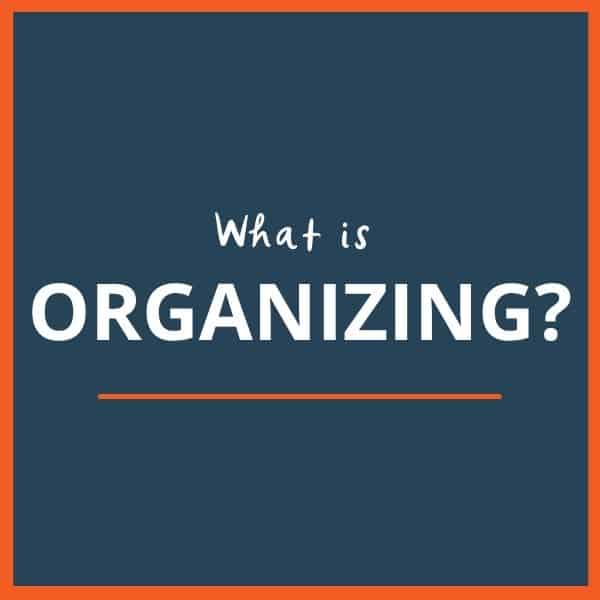
What is Organizing? An Introduction based on the Work of Marshall Ganz
So, what is organizing? Here is a basic introduction based on the work of Marshall Ganz.
Welcome to learning the organizing framework, this article introduces the essential parts of the five Leadership Practices of Organizing and coaching!
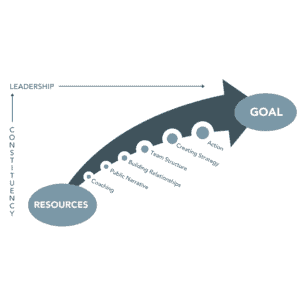
What is Organizing?
Organizing is leadership that enables people to turn the resources they have into the power they need to make the change they want. As we’ll learn throughout this guide, community organizing is all about people, power, and change – it starts with people and relationships, is focused on shifting power, and aims to create lasting change. Organizing people to build the power to make change is based on the mastery of five key leadership practices: telling stories, building relationships, structuring teams, strategizing, and acting. That is, to develop our capacity for effective community organizing, we must learn:
The Five Leadership Practices
- How to articulate a story of why we are called to lead, a story of the community we hope to mobilize and why we’re united, and a story of why we must act.
- How to build intentional relationships as the foundation of purposeful collective actions.
- How to create structure that distributes power and responsibility and prioritizes leadership development.
- How to strategize turning your resources into the power to achieve clear goals.
- How to translate strategy into measurable, motivational, and effective action.
Though organizing is not a linear process, organizers use the first three practices (stories, relationships, structure) to build power within a community, while the last two practices (strategy, action) are about wielding that power in order to create change.
People
The first question an organizer asks is “Who are my people?” not “What is my issue?” Effective organizers put people, not issues, at the heart of their efforts. Organizing is not about solving a community’s problems or advocating on its behalf. It is about enabling the people with the problem to mobilize their own resources to solve it (and keep it solved).
Identifying a community of people is just the first step. The job of a community organizer is transform a community – a group of people who share common values or interests – into a constituency – a community of people who are standing together to realize a common purpose. The difference between community and constituency lies in the commitment to take action to further common goals.
For example, a community could be residents of a town that are against a new dam project, while a constituency would be residents of the town against the dam who have signed a petition to take action to stop the dam from being built.
Organizing is a fancy word for relationshipbuilding. – Mary Beth Rogers
Power
Organizing focuses on power: who has it, who doesn’t, and how to build enough of it to shift the power relationship and bring about change.
Reverend Martin Luther King described power as “the ability to achieve purpose” and “the strength required to bring about social, political and economic change.” 1
In organizing, power is not a thing or trait. Organizers understand power as the influence that’s created by the relationship between interests and resources. Here, interests are what people need or want (e.g. to protect a river, to stay in public office, to make money), while resources are assets (e.g. people, energy, knowledge, relationships, and money) that can be readily used to, in the case of organizing, achieve the change you need or want. Understanding the nature of power – that it stems from the interplay between interests and resources – and that we must shift power relationships in order to bring about change, is essential for the success of our organizing efforts.
From the example above, the constituency against the dam may ask questions aimed at ‘tracking down the power’ – that is, inquiring into the relationship between actors, and particularly the interests and resources of these actors in their struggle. For instance, they might ask questions like: what are our interests, or, what do we want? Who holds the resources needed to address these interests? What are their interests, or, what do they want?
In doing so, the town residents may realize that their local town council is a key actor, that local councillors want to stay in office and need votes to do so, and in turn, the constituency holds the resources of people, relationships, and votes that could shift this power relationship and bring about change.
Change
In organizing, change must be specific, concrete, and significant. Organizing is not about ‘raising awareness’ or speech-making (though these may contribute to an organizing effort). It is about specifying a clear goal and mobilizing your resources to achieve it.
Indeed, if organizing is about enabling others to bring about change, and specifically, securing commitment from a group of people with shared interests to take action to further common goals, then it’s critical to define exactly what those goals are.
In the case of the proposed dam project from above, the constituency against the dam must create clear, measurable goals. Note the difference between “our goal is to stop the dam” versus “our goal is to put pressure on town council in the next 3.5 months – through door-knocking, events, and local newspaper op-eds aimed at getting 1 / 3 of town residents to sign our petition – to pass a motion to stop the dam project.”
You’ll learn how to come up with goals in the Strategizing section and how to achieve them in the Acting section.
The Snowflake Model: A distributed approach to leadership
We define leadership as accepting responsibility for enabling others to achieve purpose in the face of uncertainty, and the organizational model that best embodies this understanding of leadership is what we call the “snowflake model.”
First, in the snowflake model, leadership is distributed. No one person or group of people holds all the power; responsibility is shared in a sustainable way, and structure aims to create mutual accountability. The snowflake is made up of interconnected teams working together to further common goals.
Second, the snowflake model is based above all on enabling others. A movement’s strength stems from its capacity and commitment to develop leadership and in the snowflake model, everyone is responsible for identifying, recruiting, and developing leaders. Leaders develop other leaders who, in turn, develop other leaders, and so on.
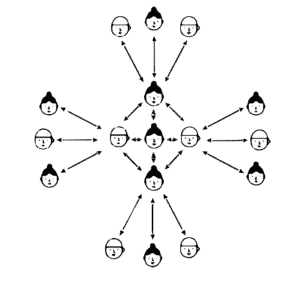
You’ll learn about the snowflake model in greater detail in the Structuring Teams section, but for now, reflect on the organizational structures that you’ve been a part of in your work, school, or other areas of your life. How might you draw out those structures? Where did you fit into those structures, and how did you feel in your role?
Now, take a look at diagram 1. Note the faces, the clusters of faces, and the links between them. How might the snowflake model compare to the structures you’ve been a part of in the past? As you’ll see in the Structuring Teams section, the snowflake model is unique from typical organizing or leadership structures in that responsibility is distributed and it prioritizes leadership development above all.
In closing, keep the snowflake model structure and the core tenets of people, power, and change in mind as we dive deeper into the the five practices of organizing: telling stories, building relationships, structuring teams, strategizing, and acting.
Five Organizing Practices
Learning how to organize people to build the power they need to make change begins with learning five key leadership practices.
|
DISORGANIZATION |
LEADERSHIP |
ORGANIZATION |
|
Passive |
Shared Story |
Active |
|
Divided |
Relational Commitment |
United |
|
Drift |
Clear Structure |
Purpose |
|
Reactive |
Creative Strategy |
Initiative |
|
Demobilized |
Effective Action |
Mobilized |
1. Creating Shared Story
Organizing is motivated by shared values expressed through public narrative. By learning the craft of public narrative we can access our shared values for the emotional resources we need to respond to challenges with courage rather than reacting to them with fear. By learning to tell stories of sources of our own values, a “story of self”, we enable people to “get us”. By telling stories of the sources of values we share, a “story of us”, we enable people to “get” each other. By recognizing the current moment as one of urgent choice and proposing a hopeful way forward, a “story of now”, we motivate action. Values-based organizing—in contrast to issue-based organizing—invites people to escape their “issue silos” and come together so that their diversity becomes an asset, rather than an obstacle. By learning how to tell a public narrative that bridges the self, us, and now, organizers enhance their own efficacy and create trust and solidarity within their campaign, equipping them to engage others far more effectively.
2. Creating Shared Relational Commitment
Organizing is based on relationships and creating mutual commitments to work together. It is the process of association—not simply aggregation—that makes a whole greater than the sum of its parts. Through association we can learn to recast our individual interests as common interests, identify values we share, and envision objectives that we can use our combined resources to achieve. And because it makes us more likely to act to assert those interests, relationship building goes far beyond delivering a message, extracting a contribution, or soliciting a vote. Relationships built as a result of one-on-one meetings create the foundation of local campaign teams, and they are rooted in commitments people make to each other, not simply commitment to an idea, task, or issue.
3. Creating Shared Structure
A team leadership structure can enable organizing that grows stronger through collaborative and cascading leadership development. Volunteer efforts often flounder due to a failure to develop reliable, consistent, and creative individual leaders. Structured leadership teams encourage stability, motivation, creativity, and accountability—and use volunteer time, skills, and effort effectively. They create a structure within which energized volunteers can accomplish challenging work. Real teams can achieve the goals they set for themselves, grow more effective as a team over time, and enable the growth, development and learning of their individual members. Effective leadership teams must be bounded, stable, and diverse. They must agree on a shared purpose, clear norms, and specific roles.
4. Creating Shared Strategy
Although based on broad values, effective organizing campaigns focus on a clear strategic objective, a way to turn those values into action; e.g., desegregate buses in Montgomery, Alabama; getting to 100% clean electricity; etc. Trans-local campaigns locate responsibility for strategy at the top (or at the center), but are able to “chunk out” strategic objectives in time (deadlines) and space (local areas) as a campaign, allowing significant local responsibility for figuring out how to achieve those objectives. Responsibility for strategizing local objectives empowers, motivates and invests local teams.
5. Creating Shared Measurable Action
Organizing outcomes must be clear, measurable, and specific if progress is to be evaluated, accountability practiced, and strategy adapted based on experience. Measures may include volunteers recruited, money raised, people at a meeting, voters contacted, pledge cards signed, laws passed, etc. Although electoral campaigns enjoy the advantage of very clear outcome measures, any effective organizing drive must come up with the equivalent. Regular reporting of progress to goal creates opportunity for feedback, learning, and adaptation. Training must be provided for all skills (e.g., holding house meetings, phone banking, etc.) to carry out the program. Social media may help enable reporting, feedback, coordination. Transparency must exist as to how individuals, groups, and the campaign as a whole are doing with regard to their progress toward their goal.
Organizing Your Constituency
This manual focuses on the design of an organizing campaign, but the real work of organizing is done with one’s constituency. As the chart below shows, organizing is about enabling a constituency to develop the power it needs to assert its interests effectively, not only in this moment, but also in the future. Organizers begin by building a foundation within their constituency. This usually requires one-on-one meetings to learn of people’s real concerns, discern real sources of their problems, figure out power dynamics, and identify, recruit and develop leadership. A campaign is a process through which a constituency can organize itself to create the power it needs to achieve its goals. And by turning their campaign efforts into an organization, they will have the capacity to build on their successes into the future.
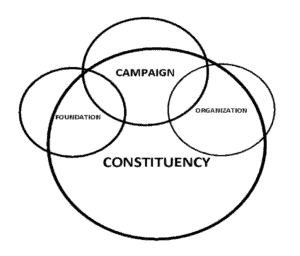
Civic engagement is also organized as a campaign: a way of mobilizing time, resources, and energy to achieve an outcome and treat time as an “arrow,” rather than a “cycle.” Thinking of time as a “cycle” helps to maintain routines, normal procedures, our annual budgets, etc. Thinking of time as an “arrow” focuses on making change, on achieving specific outcomes, on focusing our efforts. A campaign is time as an “arrow”. It is an intense stream of activity that begins with a foundational period, builds to a kick-off, builds to periodic peaks, and culminates in a final peak, followed by a resolution. Our workshop will follow the same pattern, each practice, building on what went before, and creating a foundation for what comes next.
We also take a particular approach to structuring leadership, a structure that enables us to develop the leadership of others, even as we exercise our own. Sometimes we think leadership is about being the person that everyone goes to:

How does it feel to be the dot in the middle of all those arrows? How does it feel to be one of the arrows that can’t even get through? And what happens if the “dot” in the middle should disappear?
Sometimes we think we don’t need leadership at all because “we’re all leaders”, but that looks like this:
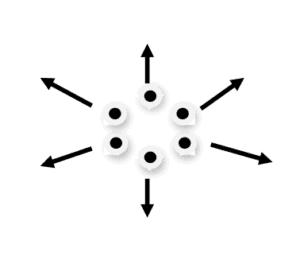
Who’s responsible for coordinating everyone? And who’s responsible for focusing on the good of the whole, not just one particular part? With whom does the “buck stop”?
Another way to practice leadership is like this “snowflake”: leadership practices by developing other leaders who, in turn, develop other leaders, all the way “down”. Although you may be the “dot” in the middle, your success depends on developing the leadership of others.
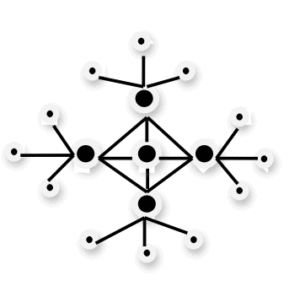
Coaching
Why is coaching an important organizing practice?
Leadership in organizing is about enabling others to achieve purpose in the face of uncertainty. Coaching enables others.
Organizing campaigns are rich with challenges and learning opportunities, but sometimes we are fish in our own water and we cannot see the challenges we are swimming in. Coaching in organizing helps to alleviate this problem. Coaching helps individuals to overcome motivational, strategic, and informational challenges that might otherwise hinder the progress of the individual, and/or the team, and thus the campaign or training.
What is coaching in organizing?
Coaching is a direct intervention in an individual or team’s work process to help them improve their effectiveness.
Coaching is a leadership practice that is useful in a variety of contexts in organizing campaigns and trainings. Some examples of when coaching skills are necessary:
- Helping an organizer overcome motivational challenges with their volunteers.
- Assisting a leadership team in creating strategy for their organizing campaign.
Coaching is useful whenever we are working to enable others to build their own capacity to act, and though the contexts vary, the process is very similar throughout.
Elements of Coaching
Coaching requires learning to identify a person’s or team’s strengths and weaknesses to help them draw upon their strengths to overcome their weaknesses.
People often know what they “should” do. But fresh eyes can help diagnose specific challenges they face while identifying ways to deal with them.
- Motivational (heart) coaching is intended to enhance effort.
- Educational (hands) coaching is intended to help acquire information or skills
- Strategic (head) coaching is intended to help evaluate how to use resources to achieve outcomes.
Coaching Approaches
- Corrective
Some coaching is aimed at helping improve poor performance (i.e., the coachee is overall not doing the leadership practice well and needs help getting up to a basic level). - Developmental
Some coaching is aimed at helping the individual achieve mastery (i.e., the coachee does the leadership practice well and is ready to become expert). Motivational Coaching Strategic Coaching HOW WHY Educational Coaching ACTION 18 Basic elements of coaching are the same (i.e., motivational, strategic, and informational), but coaching strategies may differ (e.g., consult by asking reflective questions to develop mastery vs. consult by providing expert feedback to illustrate errors in how they are thinking about the task).
How Coaching works
Coaching requires learning how to use four methods to implement 5 steps. The four methods are: asking questions, listening (head and heart), supporting, and challenging. These are the 5 steps.
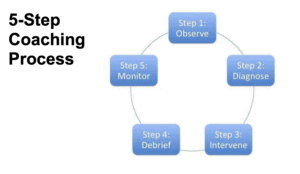
1. Observe
What do I see and hear? Listen very carefully, observe body language, and ask very focused probing questions to satisfy yourself that you “get” the problem. It may take time to get the facts straight. But if you don’t get the problem, you can’t help solve it. Don’t be shy about asking specific “stubborn” questions. This process can help the coachee articulate just what the problem is in a way they may not have before. So it’s not only “getting information.”
2. Diagnose: Why is the problem a problem?
Getting the diagnosis right really matters. For example, if an organizer is struggling with strategy and you focus on getting them to try harder the result will only be frustration.
- Is the challenge motivational (effort/heart)?
- Is the individual struggling because s/he is not putting forth enough effort? Is she not trying hard enough because she’s embarrassed?
- Is he quitting too soon because of frustration or fear?
- Is s/he getting interference from other habits (e.g., someone well-versed in marketing speak may not know how to tell an authentic story)?
- Is the challenge educational (information/skills/hands)?
- Is the individual struggling because he lacks the skill to execute effectively?
- Does he not know how to do it?
- Is she getting interference from older habits or behaviors (like someone who is so used to selling things confusing this with telling a story of self)?
- Is it something you could model or role-play with them? Is the challenge strategic (strategy/head)?
- Is the individual struggling because s/he doesn’t know how to use the information or skills that she does have.
- Does he understand the concepts or underlying principles clearly? Has he not thought it through carefully? Are the goals not achievable?
- Does the strategy make sense?
3. Intervene – What do I do?
Once you think you’ve figured out what the problem is don’t just tell the coachee what you think he should do! Find out what she thinks she should do? Ask questions that enable the coachee to see the problem, and for you to see how the coachee sees the problem, and discern a way to solve it. Get the coachee’s views out on the table. The appropriate intervention depends on the diagnosis.
If the challenge is motivational, you can:
- Encourage and exhort—you can do it!
- Offer a kick in the pants (with love)
- Help the person confront his or her fear, embarrassment, or other emotion that may get in the way of their ability to risk acting, persevering, trying new things. Communicate with empathy, hope, and affirmation of the coachee’s self-worth. Reward and praise courage
- Model courage and emotional maturity in your own behavior confess fear and explain how you move toward it rather than away from it.
If the challenge is educational, you can:
- Model the behavior and invite the coachee to imitate you to get the “feel” of the activity
- Break it down into small parts and invite the individual to try one at a time
- Offer three or four different practice exercises and observe which ones “take” for that person.
- Suggest others with whom the person can practice.
- Suggest ways to figure out where to find the missing information.
If the challenge is strategic, you can
Work through a specific example with the person, asking questions to guide the strategic process. Then reflect on the process itself, asking them to describe how it worked?
- Ask questions about how the individual is thinking about the practice (“Why did you choose that tactic?”)
- Offer your observations, asking how the person might think about it differently (“At that point, were there other options? What might they have been? Why did you choose the one you did?)
- Offer feedback on what you are hearing, asking if that describes the situation, at the same time, offering possible reframing of it.
- Use silent reflection and self-diagnosis (“Why don’t you take a moment to think through what you believe is working and not working and let’s talk about that?).
4. Debrief: What did the “coachee” learn?
Ask your coachee to summarize his or her “take away” from the session, commit to next steps, and decide when you will check back in. What went well? What are you challenged by? What are some possible solutions? What are your goals/next steps?
5. Monitor: How can I continue to support the coachee?
- Schedule periodic check-ins to support your coachee in integrating this new or revised solution into their regular practice.
- Find out from the coachee how the situation has changed.
- Assess whether the diagnosis and intervention was successful. Celebrate success!
|
Effective coaching is |
Effective coaching is not |
|
Showing up and being present to another person’s experience and listening, with both your head and heart |
Being so prepared that you work out all the answers for the coachee before you even hear or observe their challenges |
|
Helping the coachee explore and make sense of their challenges and successes, and what they learned from it all |
False praising of the coachee or only focusing on their strengths because you do not want to hurt their feelings |
|
Helping the coachee to find solutions to challenges |
Solely criticizing the coachee |
|
Asking questions that both support and challenge the person you are coaching |
Telling the coachee what to do |
Learning Organizing
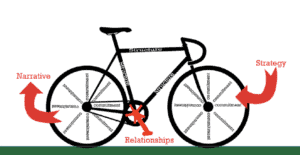
Organizing is a practice—a way of doing things. It’s like learning to ride a bike. No matter how many books you read about bike riding, they are of little use when it comes to getting on the bike. 21 And when you get on the first thing that will happen is that you will fall. And that’s where the “heart” comes in. Either you give up and go home or you find the courage to get back on, knowing you will fall, because that’s the only way to learn to keep your balance.
References
1 – King, Martin Luther, Jr. (1967). “Where Do We Go From Here?” Annual Report Delivered at the 11th Convention of the Southern Christian Leadership Conference, Atlanta, GA. Retrieved from http://www-personal.umich.edu/~gmarkus/MLK_WhereDoWeGo.pdf
Explore Further
The above information has been based on the work of Marshall Ganz and has been sourced from the following manuals.


